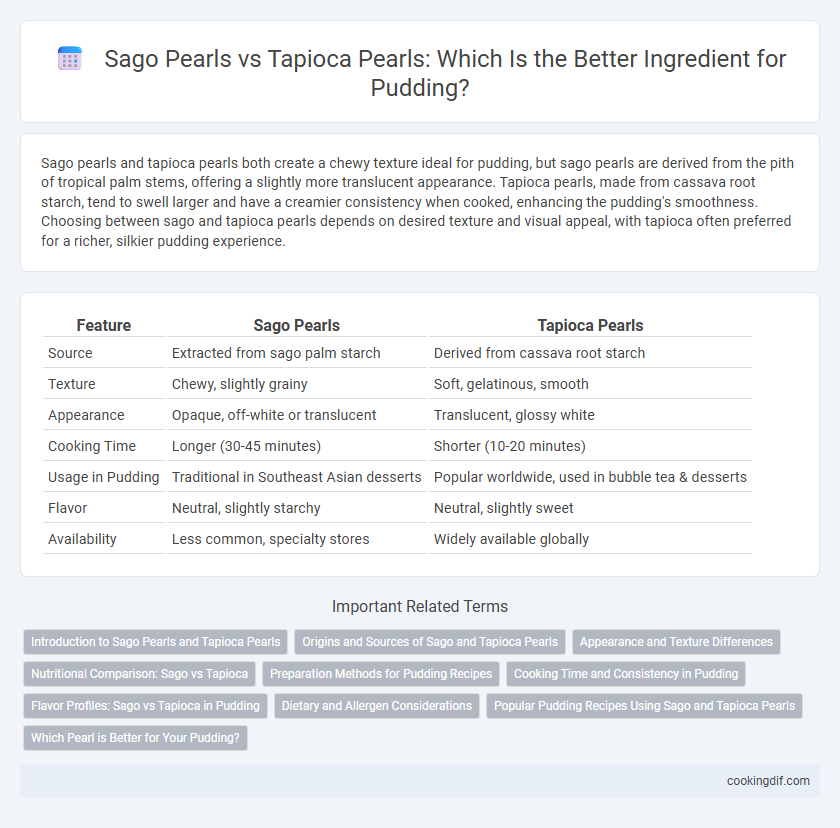Sago pearls and tapioca pearls both create a chewy texture ideal for pudding, but sago pearls are derived from the pith of tropical palm stems, offering a slightly more translucent appearance. Tapioca pearls, made from cassava root starch, tend to swell larger and have a creamier consistency when cooked, enhancing the pudding's smoothness. Choosing between sago and tapioca pearls depends on desired texture and visual appeal, with tapioca often preferred for a richer, silkier pudding experience.
Table of Comparison
| Feature | Sago Pearls | Tapioca Pearls |
|---|---|---|
| Source | Extracted from sago palm starch | Derived from cassava root starch |
| Texture | Chewy, slightly grainy | Soft, gelatinous, smooth |
| Appearance | Opaque, off-white or translucent | Translucent, glossy white |
| Cooking Time | Longer (30-45 minutes) | Shorter (10-20 minutes) |
| Usage in Pudding | Traditional in Southeast Asian desserts | Popular worldwide, used in bubble tea & desserts |
| Flavor | Neutral, slightly starchy | Neutral, slightly sweet |
| Availability | Less common, specialty stores | Widely available globally |
Introduction to Sago Pearls and Tapioca Pearls
Sago pearls are starch-based spheres extracted from the pith of sago palm stems, characterized by their translucent appearance and slightly firmer texture. Tapioca pearls, derived from cassava root starch, are widely used in puddings for their smooth, chewy consistency and ability to gelatinize when cooked. Both ingredients serve as popular thickeners but differ in origin, texture, and cooking properties, influencing the final pudding's sensory profile.
Origins and Sources of Sago and Tapioca Pearls
Sago pearls are derived from the starch extracted from the pith of tropical palm stems, primarily the sago palm found in Southeast Asia. Tapioca pearls originate from cassava root starch, a tuber native to South America but widely cultivated in tropical regions including Africa and Asia. Both are used as pudding ingredients, but their distinct plant sources influence texture and regional culinary traditions.
Appearance and Texture Differences
Sago pearls appear translucent and slightly smaller than the more opaque, slightly larger tapioca pearls, giving pudding a distinct visual appeal depending on the choice. The texture of sago pearls is more gelatinous and chewy, whereas tapioca pearls provide a firmer, more resilient bite, influencing the pudding's mouthfeel. These differences impact not only the aesthetic but also the overall sensory experience of the pudding.
Nutritional Comparison: Sago vs Tapioca
Sago pearls and tapioca pearls, both derived from starch sources, differ nutritionally in their carbohydrate and calorie content, with tapioca pearls generally containing slightly higher calories and carbohydrates per serving. Sago pearls provide minimal protein and fat, similar to tapioca, but they contain trace minerals such as iron and calcium that are less prevalent in tapioca. Both are low in fiber and vitamins, making their nutritional impact largely dependent on portion size and preparation methods in pudding recipes.
Preparation Methods for Pudding Recipes
Sago pearls require soaking and longer boiling times to achieve a translucent, chewy texture ideal for pudding, whereas tapioca pearls cook faster and provide a more gelatinous consistency. Sago often demands gentle simmering to prevent sticking, while tapioca pearls benefit from vigorous boiling followed by resting to reach optimal softness. Choosing between sago and tapioca pearls depends on the desired texture and preparation time in pudding recipes.
Cooking Time and Consistency in Pudding
Sago pearls cook faster than tapioca pearls, typically requiring around 10-15 minutes of boiling compared to tapioca's 30 minutes or more, making them ideal for quicker pudding preparation. In terms of consistency, sago pearls produce a translucent, slightly chewy texture that blends smoothly into puddings, while tapioca pearls create a thicker, more elastic texture that offers a heartier bite. Selecting sago pearls results in a lighter, silkier pudding, whereas tapioca pearls yield a denser, more substantial dessert.
Flavor Profiles: Sago vs Tapioca in Pudding
Sago pearls offer a subtle, slightly nutty flavor that enhances pudding with a delicate sweetness, while tapioca pearls deliver a more neutral taste that absorbs surrounding flavors, making them versatile for a variety of pudding recipes. The texture of sago pearls is tender and smooth, creating a creamy mouthfeel, whereas tapioca pearls are chewier and provide a distinct bite that adds contrast to the pudding. When choosing between sago and tapioca pearls, consider the desired balance of flavor intensity and texture to complement the pudding's overall profile.
Dietary and Allergen Considerations
Sago pearls are naturally gluten-free and derived from the starch of tropical palm stems, making them a suitable option for individuals with gluten sensitivities or celiac disease. Tapioca pearls, extracted from cassava root, are also gluten-free but may sometimes be processed alongside other allergens, posing a risk for cross-contamination. Both sago and tapioca pearls are generally low in allergens, but labeling checks are essential for allergy sufferers to ensure safe consumption in pudding recipes.
Popular Pudding Recipes Using Sago and Tapioca Pearls
Sago pearls, derived from the pith of tropical palm stems, provide a translucent and chewy texture ideal for traditional Asian puddings like sago gula melaka and sago coconut milk desserts. Tapioca pearls, made from cassava starch, create a more resilient, bouncy texture commonly used in recipes such as classic tapioca pudding and bubble tea-inspired puddings. Both pearly ingredients absorb flavors well but tapioca pearls tend to hold their shape longer during cooking, making them a versatile choice for a variety of pudding textures.
Which Pearl is Better for Your Pudding?
Sago pearls and tapioca pearls both create smooth, chewy textures in pudding, but tapioca pearls are generally preferred for their consistent size and translucency, enhancing visual appeal and mouthfeel. Tapioca pearls also absorb flavors more effectively and cook faster than sago pearls, making them ideal for a richer, creamier pudding experience. Sago pearls tend to be less processed and can be a better choice for traditional or rustic pudding recipes where a slightly firmer texture is desired.
Sago Pearls vs Tapioca Pearls for pudding ingredient Infographic

 cookingdif.com
cookingdif.com